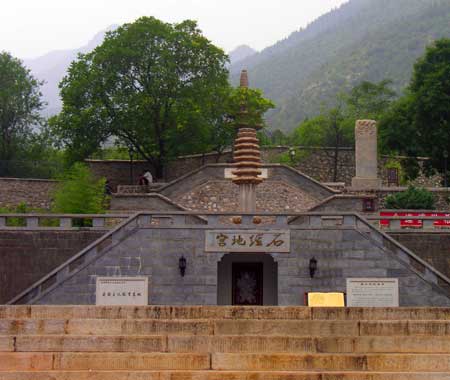Temple aspires to join UNESCO list
|
|
|
The entrance of the underground palace for storing stone sutra carvings in Yunju Temple Photo: CFP |
Yunju Temple in Fangshan district has sat on China's considered list of sites for application to UNESCO's World Heritage List for 17 years, yet there are still no defined plans as to when the country may submit it for consideration.
Two Chinese sites were inscribed on the World Heritage List during the 34th session of the committee last month, both of which had the government backing that Yunju Temple continues to lack.
Established in the late Sui (581-618 AD) and early Tang (618-907 AD) dynasties, the temple is located at the foot of Baidai Mountain. The area includes pagodas built during the Liao (907-1125 AD) and Tang dynasties and caves used to store Buddhist scriptures. It has the most stone sutra carvings in the world, according to the temple's website.
The temple was included in China's own tentative list for UNESCO application consideration in 1993, but work to bring the temple up to UNESCO standards did not start until 2003.
"We have spent about 700,000 yuan ($103,060.89) over the years, and most of that expense was for the planning of the protection of the cultural heritage here," said Zhang Aimin, director of the relics protection section of the Yunju Temple relics management department.
UNESCO's standard for list inclusion states that no modern construction is permitted within two kilometers of the core of the area in question.
"Unlike other applicants, our cost isn't much since we don't have much demolition work to be done," Zhang said. "The total expense for demolition is 100 million yuan ($14.72 million), tops. We just removed some restaurants, signal lights and barracks, not residents here."
There are about 100 families living in the village near the temple, Zhang said.
China's list of 35 possibilities for World Heritage consideration includes the Grand Canal, which runs from Beijing to Hangzhou, Zhejiang Province.
According to UNESCO's rules, one country can only submit one site each year for consideration. The Grand Canal, in a joint application by eight provinces and 35 cities, has been chosen for the year 2014. Yunju Temple is currently the only one in China's tentative list that's from Beijing.
A media department spokeswoman from the Municipal Administration of Cultural Heritage told the Global Times, "We choose Yunju Temple... because it better represents China from a histori-cal, cultural and scientific perspective."
But Zhang expressed concerns about the temple's application.
"Yunju Temple may not sound attractive to many people because it's religious. Unlike the Grand Canal project, we didn't get much funding and support from the Beijing government [ for preparation and application work]. We need money to collect more historical materials and do more research to better protect and publicize the temple."
 0
0 








Go to Forum >>0 Comments